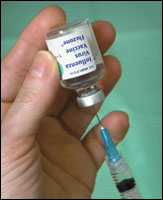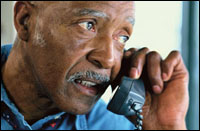Seasonal Flu
Worker Guidance
Precautions for Healthcare Workers during Flu Season
This guidance provides baseline infection control procedures for seasonal flu. As new information about the current seasonal flu virus becomes available, this workplace guidance will be reevaluated and updated. Employers should ensure that they have the most up-to-date information when making decisions about their current operations and planning.
If you perform certain types of healthcare tasks for patients who may have the flu, then you may be at a higher risk of exposure to the seasonal flu virus at work. Workers who are at risk include those who perform direct patient care, aerosol-generating procedures, specimen analysis, and other patient support, like dietary and housekeeping services. These tasks can be performed in different settings such as inpatient and outpatient healthcare facilities, home healthcare settings, and health services facilities in schools, industrial workplaces, or correctional institutions. If you are one of these workers, then you need to take precautions at work to help reduce your risk of exposure to the flu virus. These precautions include using a combination of safe work practices and personal protective equipment (PPE) to reduce your exposures. The main strategies to prevent flu transmission include:
- Getting vaccinated
- Strictly following the steps for hand hygiene and cough etiquette, and encouraging coworkers, patients, and visitors to follow them also
- Staying home if you are ill and encouraging ill coworkers to obtain permission to leave work
- Strictly following infection control practices at work
- Using the gloves, gowns, surgical masks, and other protective equipment that your employer gives you and following the steps for putting them on (donning) and taking them off (doffing) correctly.
Pandemic flu remains a concern for workers and employers, especially those in the healthcare industry. A pandemic can occur at any time and can be mild, moderate, or severe. The pandemic in 2009 was considered by CDC to be mild but it still created challenges for employers and showed that many workplaces were not prepared. The precautions identified in this guidance give a baseline for infection control during a seasonal flu outbreak, but they may not be enough to protect workers during a pandemic. Your employer’s pandemic flu plan should be based on a "worst-case" scenario – one in which the virus causes severe illness and death in larger numbers of people. Planning for the worst-case ensures that employers will have the right type of equipment and enough of it on hand to protect workers. It also ensures that employers have planned for additional control options so that they can pick the right combination for the specific pandemic flu virus. You may have additional planning considerations too. For example, you may need to think about what you’ll do if schools and daycare facilities are closed. For additional information on pandemic flu planning, see OSHA's Pandemic Influenza Preparedness and Response Guidance for Healthcare Workers and Healthcare Employers and CDC's healthcare planning resources.
You have the right to a safe workplace. The Occupational Safety and Health Act of 1970 (OSH Act) requires that employers provide their employees with working conditions that are free of known dangers. The Act created the Occupational Safety and Health Administration (OSHA), which sets and enforces protective workplace safety and health standards. OSHA also provides information, training and assistance to workers and employers. Workers may file a complaint to have OSHA inspect their workplace if they believe that their employer is not following OSHA standards or there are serious hazards.
Contact us if you have questions or want to file a complaint. We will keep your information confidential. We are here to help you.
Some Basic Precautions for All Workers
- Get vaccinated! Vaccination is the most important way to prevent the spread of the flu. For additional information about seasonal flu vaccine priorities, see Key Facts About Seasonal Flu Vaccine.
- Stay at home if you are sick. CDC recommends that workers who have a fever and respiratory symptoms stay at home until 24 hours after their fever ends (100 degrees Fahrenheit [37.8 degrees Celsius] or lower), without the use of medication. Not everyone who has the flu will have a fever. Other symptoms could include a runny nose, body aches, headache, tiredness, diarrhea, or vomiting. Note that CDC has special instructions for workers returning to work in areas with patients whose immune systems are severely weakened.
- Keep frequently touched common surfaces (e.g., telephones, computer equipment, etc.) clean.
- Try not to use a coworker's phone, desk, office, computer, or other work tools and equipment. If you must use a coworker’s equipment, consider cleaning it first with a disinfectant.
- Stay in shape. Eat a healthy diet. Get plenty of rest, exercise, and relaxation.
- If you are in a high risk category for flu complications (e.g., pregnant women, persons with asthma, etc.) talk with your employer about alternative work assignments.
- Participate in all training offered by your employer. Make sure that you understand your exposure risk, your facility's policies and procedures for isolation precautions, use of workplace controls, work practices, and PPE protection during aerosol-generating procedures, and potential complications of the flu.
Additional Precautions for Healthcare Activities
Your employer should use a combination of the workplace engineering controls, work practices, and personal protective equipment listed below to reduce your exposure to the flu. Engineering controls are the most effective ways to reduce exposure because they involve changes to the workplace. Engineering controls should be used first. PPE is the least effective way to reduce exposure. PPE should be used only when close contact cannot be eliminated any other way. Follow your employer's procedures for implementing these controls and use the protective equipment provided to reduce your exposure risk at work.
Engineering Controls and other Workplace Control Measures
- Modify patient intake, triage, and other service areas to increase space between workers, coworkers, and patients (e.g., install sneeze guards or partitions).
- If available, use airborne infection isolation rooms (AIIRs), for aerosol-generating procedures and limit the number of people present during the procedure.
- Isolate and group flu patients according to your facility’s procedures.
- Use the appropriate Biosafety Level, in laboratories, when handling specimens from flu patients.
- Limit patient transport. Conduct exams and procedures at the bedside, instead of transporting the patient to other areas of the facility. Place a surgical mask on the patient, if tolerated, when they are being transported out of the room.
- Use closed suctioning systems to suction a patient’s airways and use high quality filters on the expiratory port of ventilators, when available.
Safe Work Practices
- Screen incoming patients and separate those with flu-like symptoms.
- Limit the staff entering patient isolation rooms to only those necessary for patient care.
- Restrict visits for patients in isolation.
- Use proper respiratory and cough etiquette and encourage hand washing by patients and visitors.
- Cover your coughs and sneezes with a tissue or cough and sneeze into your upper sleeve(s). Dispose of tissues in a "no touch" wastebasket.
- Clean your hands after coughing, sneezing, or blowing your nose.
- Avoid touching your nose, mouth, and eyes.
- Wash your hands with soap and water for at least 20 seconds before and after contact with patients, after using PPE, and after touching contaminated surfaces; use an alcohol-based hand rub if soap and water are not available.
- When using soap and water, rub soapy hands together for at least 20 seconds, rinse hands with water, and dry completely.
- If soap and water are not available, use of an alcohol-based hand rub is helpful as an interim measure until hand washing is possible. When using an alcohol-based hand rub, apply liquid to palm of hand, cover all surfaces of the hands with the liquid, and rub hands together until dry.
- Check yourself for symptoms of the flu.
- Follow standard cleaning and disinfection methods.
Personal Protective Equipment (PPE)
- Use a surgical mask when entering a flu patient's room. A surgical mask is not a respirator. It will not protect you during aerosol-generating procedures, which may create very fine aerosol sprays. A surgical mask can only be used to protect workers from contact with the large droplets made by patients when they cough, sneeze, talk or breathe.
- Use a respirator during aerosol-generating procedures; a fit tested N95 disposable respirator or better is needed.
- Use gloves, gowns, and eye protection for any tasks that might cause contamination or create splashes.
-
Put on and take off protective equipment in the correct order to prevent contamination.
- CDC Posters
- Sequence for Donning and Removing Personal Protective Equipment (PPE). Shows correct way to put on and take off PPE.
- CDC Posters
This guidance is advisory in nature and informational in content. It is not a standard or regulation, and it neither creates new legal obligations nor alters existing obligations created by OSHA standards or the Occupational Safety and Health Act. Pursuant to the OSH Act, employers must comply with safety and health standards and regulations issued and enforced either by OSHA or by an OSHA-approved State Plan. In addition, the Act's General Duty Clause, Section 5(a)(1), requires employers to provide their employees with a workplace free from recognized hazards that are causing or are likely to cause death or serious physical harm.




